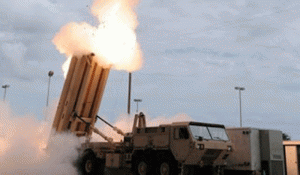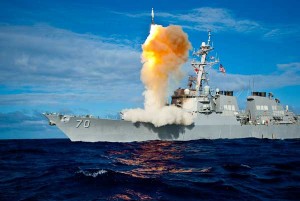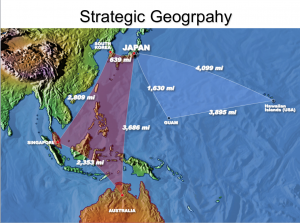2014-01-07 by Ed Timperlake
In our recent book on the rebuilding of American military power in the context of shaping a new Pacific strategy, we highlighted the significance of shaping a new template for the synergy between defense and offense.
With the new multi-mission systems – 5th generation aircraft and Aegis for example – the key is presence and integration able to support strike or defense in a single operational presence capability. Now the adversary cannot be certain that you are simply putting down a marker.
This is what former Air Force Secretary Michael Wynne calls the attack and defense enterprise.
The strategic thrust of integrating modern systems is to create an a grid that can operate in an area as a seamless whole, able to strike or defend simultaneously. This is enabled by the evolution of C5ISR (Command, Control, Communications, Computers, Combat Systems, Intelligence, Surveillance, and Reconnaissance), and it is why Wynne has underscored for more than a decade that fifth generation aircraft are not merely replacements for existing tactical systems but a whole new approach to integrating defense and offense…..
By shaping a C5ISR system inextricably intertwined with platforms and assets, which can honeycomb an area of operation, an attack and defense enterprise can operate to deter aggressors and adversaries or to conduct successful military operations.
https://sldinfo.com/crafting-an-attack-and-defense-enterprise-for-the-pacific/
Our interview with PACAF Commander, General Hawk Carlisle, highlighted a key way ahead is forging various paths towards cross-domain synergy among the joint and coalition forces.
One of the key examples he provided was the role of the first THAAD deployment to the Pacific.

Thanks to a demonstrated rapid THAAD deployment to Guam, the Air Defense Artillery (ADA) branch of the US Army has demonstrated their significant role in US and Allied Air Sea Battle planning.
We followed up on Carlisle’s illustration to interview the Guam commander of the THAAD battery.
And this interview made it clear that ADA capability far transcends moving infantry around the Pacific tying up precious Air Force resources. Army Pacific battle planning was reported as being called “Pacific Pathways.”
In a recent Washington Post article the Senior Army Pacific Commander, General Brooks, a command based in Hawaii, was recently elevated to four stars, and makes a significant point:
“We can no longer afford to build [combat] units and put them on a shelf to be used only in the event of war,” the Senior Army Pacific Commander’s command wrote in an internal planning document.
He is exactly correct and the best answer to General Brooks thinking is very simple: just don’t do it.
There is no need for a large standing army to be built. America has shown the ability to very successful in mobilizing what is often called “trigger pullers.”
In fact The Washington Free Beacon has given a wonderful tribute to the men and women in today’s US Army. “2013 Man of the Year: The American Soldier.”
With the Afghan transition comes the opportunity to shift from a land heavy mobilization force. Indeed in our forthcoming piece in the Joint Forces Quarterly, we argue that the decade ahead has little in common with the decade behind and that “the force being remade by new technologies ripening in the decade ahead, there are significant possibilities for innovation and re-shaping of the force structure.”
In the decade ahead, it is clearly the time for Big Army demobilization.
The current Chief of Staff of the US Army, General Odierno, West Point 1976, has an appreciation for the combat legacy of the Long Gray Line. As a strong advocate for the US Army, he told Congress and hence the American people that to win a war send in the Army. He was exactly right for the Civil War, WWI and WWII.
Unfortunately, unless he wants to argue to support, equip and train a standing “Big Army” to capture Beijing or Tehran, his vision for Army resources has to be modified to recognize the realities of the potential combat facing America in this half of the 21st Century.
Hussein assumed that Kuwait was his. Neither Iran nor China should believe that they can make such an assumption about any of their neighbors.
It is American power projection backed by mobilization if necessary which adds a key deterrent quality to Iranian or Chinese thinking.
America, can mobilize an Army, but the need for ready now survivable aircraft, and air bases and Navy ships with a 9/11 force of US Marines afloat to shape an attack and defense enterprise is the key challenge.
And not funding these forces along innovative lines while maintaining an Army built for Iraq and Afghanistan makes little sense in the decade ahead.
Our role is to shape global reach and bring power to bear for our allies, which makes any adversary like Iran or the PRC lack certainty that a perimeter attack on one of their neighbors is just that.
Also involved is the challenge of shaping a key understanding of the appropriate tactical and strategic role of the US Army in the Pacific. One just has to look at the geography of the Pacific and ask why just Guam and does a THAAD Battery always have to be moved by truck?
The answer to this question is part of a larger question: how does Army missile defense play in the attack and defense enterprise within the strategic quadrangle?
US Navy and Japanese Aegis ships, THAAD on islands, and “Rapid Raptor” which are a parts of an evolving con-ops that can be proof of concept for F-35 and tankers can make tactical and strategic moves to many PacRim airfields.
The problem is the US Army is not a lift command. It borrows USAF lift to move around the vast Pacific. And the Afghan war has weighed heavily on the lift and tanking resources of the USAF and its ability to support the joint force.
What is needed is to rethink how to support ADA in the Pacific without overtaxing lift assets.

An alternative way to think about the ADA approach is to build the support facilities throughout the Pacific whereby THAAD and air defense can be supported. THAAD–globally transportable, rapidly deployable capability to intercept and destroy ballistic missiles inside or outside the atmosphere during their final, or terminal, phase of flight. THAAD Weight launch vehicle, fully loaded 40,000kg=88, 184 lbs or 44 short tons.
http://oshkoshdefense.com/variants/m985a4-guided-missile-transporter-gmt/
The Gross Vehicle Weight Rating (GVWR) of missile battery truck alone is 66,000 lbs.
Now let us rethink how it might be deployed to remote islands as part of a flexible grid.
The CH-53 can take 30,000 lbs internal or sling 36,000 external-range unrefueled is 621 nm. The MV-22 human capacity is 24 combat-loaded Marines-range app 700 miles.
The actual missile battery is 26,000 lbs and well inside the lift capacity of a CH-53.
The problem is the mechanics to raise and lower the battery and rearm. A battery lowered from the air sans truck on reinforced concrete pads with calibrated launch points may make sense. A separate modular lift device could be put in place to load and reload.
Consequently, taking apart modules doesn’t appear to be a showstopper, and Marine MV-22s flying in Army ADA troops into any reasonable terrain is absolutely no problem.
The weight of TOC and Radar maybe of concern, and it appears that in todays world there may have been little appreciation by Big Army on using MV-22 and CH-53Ks.
To be very fair the US Vietnam War Army did get it brilliantly by setting up firebases in remote areas with helo lift of very heavy guns.
A THAAD island maneuverability concept is the same in principle but with different technology.
Combine ADA Batteries with the ability to move a floating airfield as needed inside the potential sanctuary of a 200+ KM protection umbrella of disbursed island bases with ADA batteries and power projection of the sort needed in Pacific defense is enhanced.
The targeting and thus war fighting capability of a projected threat from any PLAA2AD becomes incredibility complicated. A distributed offensive defensive grid is an additional factor in the US current PLA or North Korean IRBM kill chain R&D efforts.
The most fundamental point is US technology is already tested. Some weapons already in combat others on ranges. The US does do rigorous testing and has many important ways to share technology with all allies.
In contrast, the PLA has not tested any of their asserted A2AD capability, which is much quoted in US-search, acquisition, launch, guide, and end-game maneuver. So far they have poked a few holes in their land target outlined like a Navy Carrier. This is 1960s stuff.
The involvement of THAAD in an Aegis engagement grid may actually give” Big Army” employing ADA capability both a realistic and important way ahead to for them to make a contribution to the Air Sea Battle within resources available.
Currently it looks like the Army is assuming they can utilize AF lift as their announced right to move 700 troops around the Pacific every three months, which is an incredibly waste of resources and taxing on a lift fleet already stretched to the limit. The Afghan tax on Air Force lift has to be paid back.
The Marines know how to maneuver forces at sea and in the air to protect islands–and also deny the PLA any opportunity for them to go “feet wet” to grab Islands for their strategic use.
The USAF could stage an Army THAAD battery on a runway anywhere around Pacific. The USAF would have no problem doing just that and it sure beats the resource drain on AF heavy lift of moving 700 Army troops around every three months as proposed in their Pacific Pathways emerging doctrine.
The THAAD package could go from the runway to an Amphip, Deck or directly to MV-22s and Heavy lift helos to move this capability to a couple of rocks jutting out of Pacific.
The Island Geography around the Pacific Rim is a critical physical reality which such a deployment approach can play to:
Japan is an archipelago of 6,852 islands;
The Philippine archipelago comprises 7,107 islands, of which only about 2,000 are inhabited;
Korea has more than 3,300 islands;
Vietnam has 20 Islands-including their claim on Sprats and Parcels cluster;
And finally, Republic of China islands provide additional deployment options.
The geography of islands inside the Pacific strategic quadrangle can favor moving a THAAD Battery to various pre-planned island launch pads to protect vital runways and harbors.

When combined with Aegis ships and 7th AF maneuverability, cross-domain synergy is enhanced which can then greatly complicate PLA and NK targeting and thereby enhance deterrence.
So much for the “run-away” A2AD bogy man-especially with F-35 arrival in the region, which will extend significantly the forward reach of the sensor package to work with defensive systems!
Now if the US National Command Authority and Secretary of Defense could just convince the Army to consider accepting a strategic view that cross-domain 21st Century technology (not just boots on the ground for their own sake) can move war wining capability ADA into a strategic battle position inside our Strategic Quadrangle by Air instead of “the caissons go rolling along ”
The biggest show stopper could be fighting a tradition from 1908 (date of song)-that has very little appreciation for an Air/Sea Battle–over the expanse of the Pacific OCEAN.
WW II was Island hopping for offensive air power-but first the enemy air threat had to be beaten back, or there would be big holes in runways and destroyed aircraft on the ground.
One could imagine the PLAAF and 2nd Arty surprise if a lot of “rocks” off shore around PRC became fortified shooters linked into Aegis Carrier Battle Groups, the USN/USMC “Gator Forces” and 7th AF air mobility and Pacific strike capability mutually cross linked and reinforced with allied capability into a solid honeycomb of Pacific defense only activated when needed.

